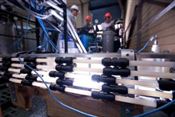Is Low-Energy Desalination One Step Closer?
April 16, 2012

A pilot trial of the membrane distillation process demonstrated treatment of industry wastewater producing high quality water using minimal electricity.
This Smart Water Fund (Victorian Government) and WQRA funded project, in partnership with City West Water and GWM Water (Victorian water authorities) aimed to demonstrate the potential of the membrane distillation process to exploit waste heat from a natural gas fired power station to treat saline effluent, producing high quality water for on-site reuse.
Membrane distillation (MD) is a thermally based desalination process that differs from other membrane separation technologies. The process can treat water using low grade heat, such as solar or waste heat, and avoid high electricity demands of RO, with its associated greenhouse gas emissions. Effluent from an industry generating waste heat is treated, producing distilled water for reuse thus substituting precious potable water and reducing discharge volumes to sewer.
The project featured a three month site trial of Victoria University's most recent membrane module design at Ecogen Energy's Newport Power Station treating their effluent stream. The pilot plant was constructed with a multilayered flat sheet PTFE membrane module in the Direct Contact MD configuration and with all necessary controls and datalogging for unattended operation. The trial successfully treated the power station's effluent continuously from September to December 2011.
Analysis of the performance data has shown the MD plant, using very low grade heat between 30 and 38 °C, desalinated the 4,000 mg/L TDS effluent producing distilled product water at between 2 and 3 L/hr, 24 hours per day over the duration of the trial. The maximum water recovery achieved was 93% with a reject water concentration of greater than 70,000 mg/L and salt rejection of 99.97%.
The experiment successfully tested the MD process' longevity and robustness, demonstrating a system driven by waste heat at input temperatures as low as 30°C, which achieved permeate flux of 3 - 4 L/hr/m2 (water produced per area of membrane used), of highly desalinated water. This strengthens the assertion of MD being a viable treatment technology for industrial effluent to recover potable water without an increase in greenhouse gas emissions.
SOURCE: Victoria University
Copyright © 1996 - 2012, VertMarkets, Inc. All rights reserved. To subscribe or visit go to: http://www.wateronline.com